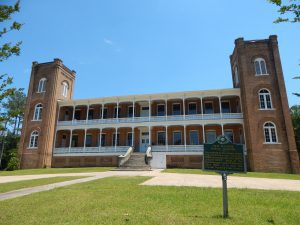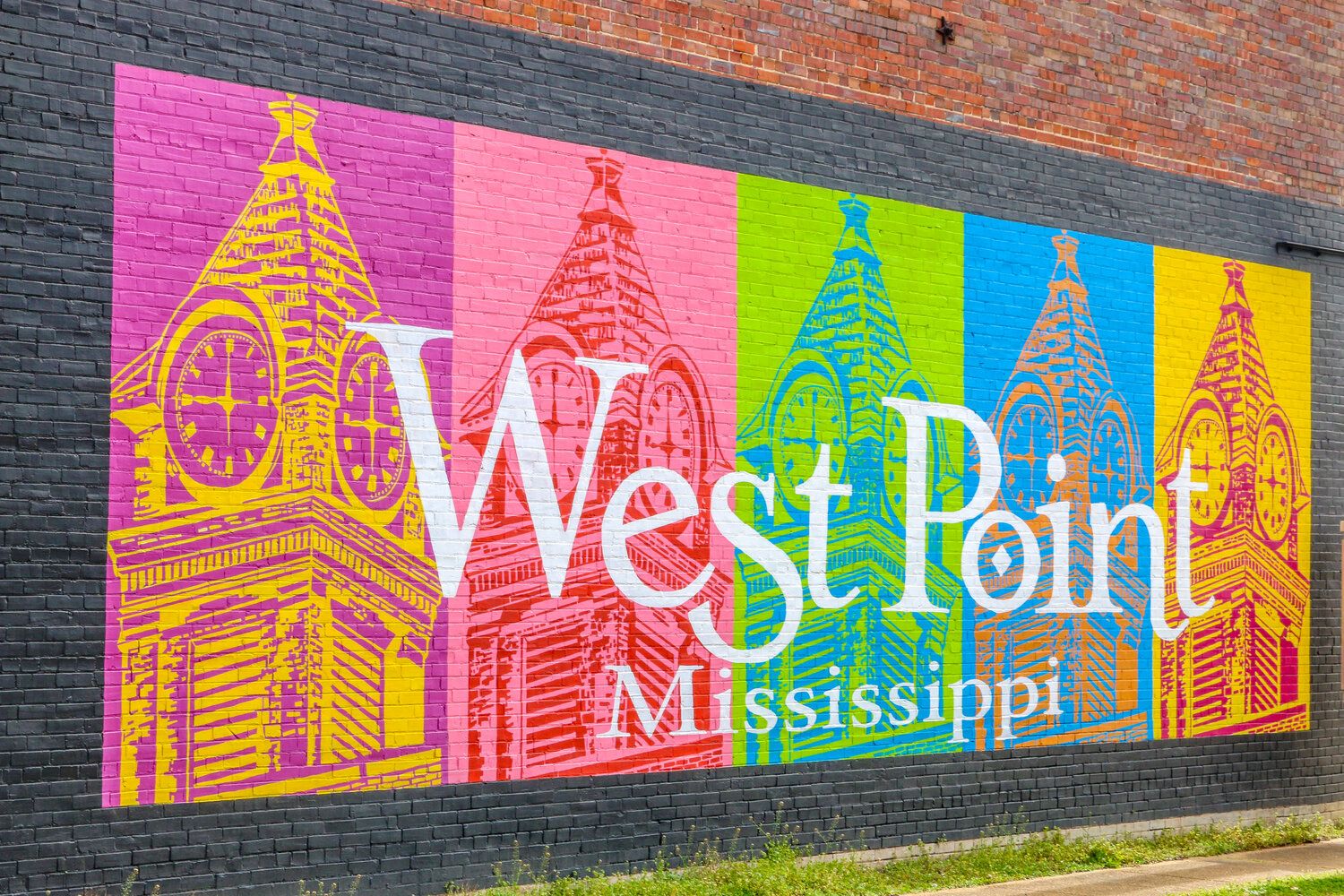
The historic school became an ideal place for class reunions, proms, meetings, and even weddings. But, like many places, the pandemic screeched events at the school to a halt, and it has yet to be used again.
Getting to the town of Wesson, Mississippi means driving on two-lane highways and country roads. Wesson is the epitome of a small town with active residents who have been rooted in the Copiah County town for their entire lives. They carry on much in the way their families did before them—they enjoy their little community and relish any opportunity to celebrate it.
There are more historic landmarks in Wesson than there are stoplights. The old Mississippi Mills now serves as the Milltown Mall and Flea Market. Another marker highlights the location of the former Wesson Hotel, which was owned and operated by Mississippi Mills. Whether on a cloudy, rainy day or a day with clear blue skies, these historic markers just seem to glow, like a front porch light welcoming you home, where all the love, pride, and stories reside.
But there’s one pillar of history in Wesson that is tucked away. Outside of the town, the Romanesque building isn’t well-known. People in the nearby cities of Hazlehurst and Brookhaven have hardly heard of it, much less seen it.
The Old Wesson School is hidden away from the line of sight. A two-lane road takes you past an all-in-one gas station, eatery, and laundromat called Shop and Wash. A turn over the railroad tracks leads you down what appears to be another small-town residential street when suddenly, through the trees, a towering building appears, and the little street dead ends back to the late 1950s when the last graduating class took its picture on the steps.
The Birth and Life of the Old Wesson School
The Old Wesson Public School, known affectionately as Old Wesson School, was first built in 1889. It served as the first brick school building for children in the area. Initially, the school was set to house grades kindergarten through 8th grade. The first semester of the Old Wesson Public School started in September 1889. In December of 1890, the school was destroyed by fire.
A book entitled “Wesson: The Industrial City of the South,” by Durr Walker and David Higgs, suggested that the students from the Old Wesson School may had been moved to the nearby Baptist church in Wesson or to the Clanton building, which was west of Town Hall, though there were no official papers to determine the exact relocation of the classes.
No time was wasted in rebuilding the school. The first graduating class—all six students— got their diplomas at the end of the 1892-1893 school year, though once again, there’s no formal evidence suggesting when exactly the graduation ceremony took place.
The school held grades kindergarten through 8th grade until 1929 when the Agricultural High School on the Copiah-Lincoln Community College campus dropped the ninth grade. In 1929, ninth-grade students joined Wesson Public School, followed by tenth grade in 1930. Seventeen years later, 9-12th grade students were back at the Co-Lin campus during their four years at the Copiah Lincoln Agricultural High School.
Old Wesson School held its final graduation in 1959. In 1960, Old Wesson School closed, following the opening of the Wesson Attendance Center on Grove Street, which to this day continues to be a school for kindergarten through 12th grade.
In 1979, Old Wesson School was added to the National Historic Register.
Three decades came and went since the school closed as the Old Wesson School building served several purposes. The basement, which was once the cafeteria, housed the local Boy Scouts. The Wesson Garden Club met at the school, as well as a nutritional program that provided free meals for senior citizens.
Ruin, rumor, renovation, revival
By 1994, the once glorious building was left empty. Over the years, a lack of funding and local interest had made parts of the school uninhabitable. Stairwells were rotted, and the roof leaked, which led to ceilings being damaged—it was more a hazard than a home for any real purpose.
By 2001, the school was named one of the Top 10 Most Endangered sites in Mississippi by the Mississippi Heritage Trust. Renovations began at the Old Wesson School in 2002, to make way for St. Ambrose Leadership College to open an all-male school at the historic location; however, it never happened.
The empty school became the center of many a rumor and gave a creepy vibe to the town. Students from the Wesson Attendance Center would climb atop the monkey bars and look down the way toward the school, towering above a treeline, next to a graveyard.
“I used to get a very creepy vibe from looking at that school,” said Annalize Warren, a former Wesson Attendance Center student. “I could see that school and the graveyard. It was just unsettling to see, and everyone talked about the ghosts and stuff.”
Old Wesson School provided a nearly cinematic sight to behold from “the new school on the hill” and left generations of elementary students speculating about the possible deaths, cults, and other general wickedness that must have taken place there (though certainly did not at least, there’s no such evidence).
The kids weren’t the only ones with the big imaginations, though. Ghost hunts have taken place at the Old Wesson School, conducted by the Mississippi Paranormal Society.
How the school stands now
Though St. Ambrose began renovations, the school never came to be. However, it did spark a fire to rally funding. Renovations were completed, and during the 2010s, the Old Wesson School became a thriving community center once again.
The historic school became an ideal place for class reunions, proms, meetings, and even weddings. There were several town Christmas events and haunted houses there as well. But, like many places, the COVID-19 pandemic screeched events at the school to a halt, and it has yet to be used again.
Sonya Cowen is a retired school librarian. Her father was the principal at the Old Wesson School, and her mother taught elementary classes there. Cowen herself was a student at the school until 1959.
“We were the last ones to graduate from there until they moved everyone up to the new school,” said Cowen.
Any child of a principal or teacher could feel like their lives centered around the school, and over the years Cowen has chosen numerous times to continue to advocate for the school, even at her own expense.
“I’ve given money to fix things here and there, like some of the wood flooring,” said Cowen.
She’s also led tours there to bring awareness to the conditions of the school and attended nearly every board meeting, with several classmates and concerned citizens, to stay informed and continue to rally for improvements at the school.
Cowen isn’t the only former student of the school that hopes to see it back in use again.
“There was a lot happening there for a while,” said Janice Stricklin, who was part of the first class to move from Wesson Public School to Wesson Attendance Center. “It hurts to see it empty now. My classmates and I still feel a connection to the Old Wesson School as our elementary school, since we were only at the attendance center for a year before starting high school.”
Stricklin said that while the inside of the school is not in use, she and about 25 of her former classmates met at the school to take a picture out front.
“It’s just a very special place,” said Stricklin. “It had a lot going for it, and it does bother me to see it empty again.”
Cowen said while COVID was the main reason for events stopping at the school, there were a few logistical things that were already causing the activity to wane.
“There’s not a real kitchen in the school,” said Cowen. “So, caterers weren’t fond of events there. It was so difficult to bring everything in and set it up.” Along with no kitchen, there are also continuing HVAC issues.
Some of the outdoor woodwork, which gives the school its historical Romanesque allure, needs repair.
“The way that woodwork was done on the school, it isn’t really done anymore,” said Cowen. “We’ve had local people even try to find the equipment to do it, but it can’t be found.”
Being on the National Register of Historic Places means that they have to stick as close to the original design as possible with renovations. However, that can be a costly ask.
“To keep it like the original, we’d have to spend thousands upon thousands of dollars for the right equipment to (restore the original detail of woodwork). Even then, that level of work just isn’t as appreciated anymore, so the cost would outweigh the benefit of fixing it to the original look,” said Cowen.
Cowen said that there is some grant money available for the school so the town could begin renovations soon, but given the historically tumultuous journey of The Old Wesson School, Cowen was reluctant to say how much money was allocated or what the timetable for those renovations would be.
“I just hope to see it back in use again,” said Cowen. “I have so many fond memories there, and I really do love it.”
For more information about the Old Wesson School, visit the Town of Wesson website.











